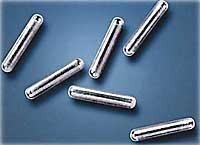Medical radioactive isotopes

The technique used is called brachytherapy and is not a new technique. In fact, in Spain for about ten years, it has been used to fight prostate cancer. The progress achieved by the Universidad Clínica de Navarra, therefore, is not in the technique itself, but in the treatment of cases of breast cancer for the first time in the use of the paladium-103 isotope. This isotope is injected to the patient by small capsules, seeds.
If the results are satisfactory, doctors expect that paladium 103 can be applied in other cases of cancer, so treatments will diversify. In addition, this technique prevents the use of surgery. However, they have only tried it in small breast tumors or newly initiates.
The main advantage of brachytherapy is that it eliminates cancer without damaging the healthy tissues and organs that are next to it. In addition, it is often enough to place a single range of radioactive seeds to completely eliminate cancer, so it is not necessary to repeat the treatment.
Exact puncture
First, the doctor takes pictures and plans of the tumor to begin therapy and in view of these images, discovers the location and nature of the tumor. This calculates the number of radioactive seeds to be implanted and where it is most important. It should be taken into account that the choice and delimitation of the area to be treated is accurate, so it is very important that each seed is placed in certain coordinates.
To do this, as has already been indicated, no surgery is required, but there are needles that perform the surgery. The needles are inserted into the patient's chest using a tomography system and doctors see their trajectory on the screen at all times. Once they reach the desired place, put seeds in the needles and place them in the chest.

These capsules or seeds of titanium contain inside a radioactive resin, in this case the element paladium-103. This element releases radiation and is what is used to destroy the cancer around.
This therapy has only been applied to patients with high surgical risk, such as people with low lung capacity or who cannot undergo surgery for a second disease. For them, it is a safe technique, less aggressive than radiation therapy or intervention, which allows the patient to accelerate and accelerate without just pain.
This technique may have two problems: the entry of air into the chest and the appearance of bleeding. However, they are seen in the intervention itself and, therefore, they are confronted immediately. However, in the intervened patients, there has been no problem of this type or of another type.
Permanent brachytherapy
The radioactive seeds of paladium 103 have already been applied to four patients. The seeds can be put to the patient temporarily or permanently and in the case of palladium is forever. That is to say, the seeds that enter remain in the body of the patient, but by releasing a low energy radiation, treatment can be completed in a few weeks. Therefore, there is no risk to the patient, the family, or the doctor.
After this fourth intervention, the Clínica Universitaria has published the results. He has moved his therapy to Bradytherapy magazine, which as has already been indicated is the first time paladium-103 is used in breast cancer cases. We hope it will remain a success of these first editions.
www.ihobe.net
Paladium-103 versus iodo-125: two isotopes
In brachytherapy implants, two radioactive isotopes are mainly used: paladium-103 and iodo-125.

The seeds of palladium and iodine are very similar, have the size of a grain of rice and are applied in the same way. Both emit low radiation, but the time it takes to release it is different.
This time is defined by the half-life of an isotope. The half-life is the time the isotope takes to lose half of its radiation. In fact, the iodo-125 has an average life of 60 days, so it loses half its strength in 60 days. After another sixty days, it will have a quarter of its validity, that is, it will take a year to rise.
The palladium, on the other hand, has an average life of 17 days, much shorter. At three months he has lost 97% of the energy and at six months he is practically without energy. Hence, it is especially appropriate for the case of fast and aggressive cancers, so it has been selected at the University Clinic to treat breast cancer.






